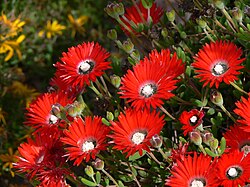| Drosanthemum | |
|---|---|
 | |
| Drosanthemum speciosum | |
| Scientific classification | |
| Kingdom: | Plantae |
| Clade: | Tracheophytes |
| Clade: | Angiosperms |
| Clade: | Eudicots |
| Order: | Caryophyllales |
| Family: | Aizoaceae |
| Subfamily: | Ruschioideae |
| Tribe: | Ruschieae |
| Genus: | Drosanthemum Schwantes |
| Species | |
90-120 - see text | |
Drosanthemum (the dewflowers) is a genus of succulent plants in the ice plant family native to the winter-rainfall regions of southern Africa, including Namibia and the Cape Provinces and Free State of South Africa. [1] Most species bear colorful flowers.
Contents
The name Drosanthemum means "dew-flower" in Greek, and refers to the characteristic shiny translucent papillae, which cover the succulent leaves and flower buds. [2]